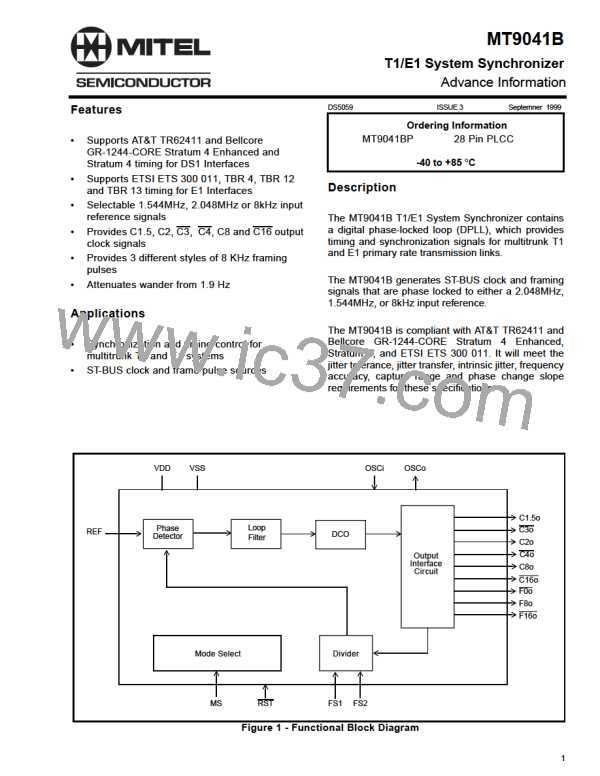Advance Information
MT9041B
All frame pulse and clock outputs have limited driving
capability, and should be buffered when driving high
capacitance (e.g. 30pF) loads.
Freerun Mode
Freerun Mode is typically used when a master clock
source is required, or immediately following system
power-up before network synchronization is
achieved.
Master Clock
The MT9041B can use either a clock or crystal as
the master timing source. For recommended master
timing circuits, see the Applications - Master Clock
section.
In Freerun Mode, the MT9041B provides timing and
synchronization signals which are based on the
master clock frequency (OSCi) only, and are not
synchronized to the reference signal (REF).
Control and Modes of Operation
The accuracy of the output clock is equal to the
accuracy of the master clock (OSCi). So if a ±32ppm
output clock is required, the master clock must also
be ±32ppm. See Applications - Crystal and Clock
Oscillator sections.
The MT9041B can operate either in Normal or
Freerun modes.
As shown in Table 2, pin MS selects between
NORMAL and FREERUN modes.
MT9041B Measures of Performance
MS
Description of Operation
The following are some synchronizer performance
indicators and their corresponding definitions.
0
1
NORMAL
FREERUN
Intrinsic Jitter
Table 2 - Operating Modes
Intrinsic jitter is the jitter produced by the
synchronizing circuit and is measured at its output. It
is measured by applying a reference signal with no
jitter to the input of the device, and measuring its
output jitter. Intrinsic jitter may also be measured
when the device is in a non-synchronizing mode, i.e.
free running mode, by measuring the output jitter of
the device. Intrinsic jitter is usually measured with
various bandlimiting filters depending on the
applicable standards.
Normal Mode
Normal Mode is typically used when a slave clock
source synchronized to the network is required.
In Normal Mode, the MT9041B provides timing
(C1.5o, C2o, C3o, C4o, C8o and C16o) and frame
synchronization (F0o, F8o, F16o) signals, which are
synchronized to reference input (REF). The input
reference signal may have a nominal frequency of
8kHz, 1.544MHz or 2.048MHz.
Jitter Tolerance
From a reset condition, the MT9041B will take up to
25 seconds for the output signal to be phase locked
to the reference.
Jitter tolerance is a measure of the ability of a PLL to
operate properly (i.e., remain in lock and or regain
lock), in the presence of large jitter magnitudes at
various jitter frequencies applied to its reference.
The applied jitter magnitude and jitter frequency
depends on the applicable standards.
The reference frequencies are selected by the
frequency control pins FS2 and FS1 as shown in
Table 1.
Jitter Transfer
Jitter transfer or jitter attenuation refers to the
magnitude of jitter at the output of a device for a
given amount of jitter at the input of the device. Input
jitter is applied at various amplitudes and
frequencies, and output jitter is measured with
various filters depending on the applicable
standards.
5

 MITEL [ MITEL NETWORKS CORPORATION ]
MITEL [ MITEL NETWORKS CORPORATION ]